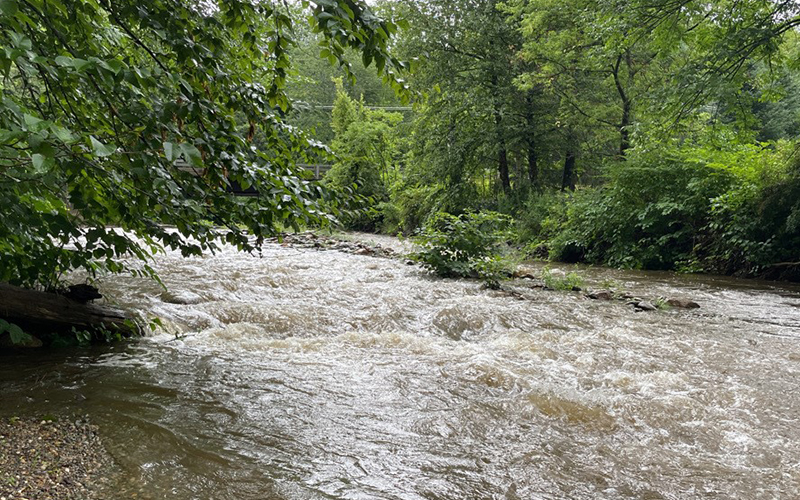On July 24 and 25, teams of Mad River Watch volunteers visited their field sites to collect important data and make careful environmental observations for the first time this year. This article is part of an ongoing series that shares highlights from this field work as well as lessons learned from the past 38 years of Friends of the Mad River’s (Friends) Mad River Watch program.
MEASURING CLIMATE CHANGE
Friends of the Mad River has been tracking water temperatures since 1988. “Water temperature is a fundamental factor in aquatic systems,” says Friends director Corrie Miller. “It influences virtually everything happening in a water body such as the speed of biological and chemical reactions and the presence and type of aquatic organisms like algae, plants, snails and fish. It also offers a good reflection on the broader changing climate.”
Water temperature can be impacted by a number of factors, including the air temperature, the source of the water (if it’s coming from underground or as surface runoff), depth, and tree cover. Each of these factors are also influenced by climate change or by changes humans make to the surrounding landscape. “In the Northeast, as a result of climate change, we can expect hotter summer temperatures,” says Friends Stewardship manager Ira Shadis. “Warmer air will directly heat up the water. We can also expect more precipitation, although there will also be periods of drought as we see greater variability in weather patterns.”
Vermont and much of the United States have been experiencing a heatwave over the last few weeks. “We saw higher readings across the board,” noted the volunteer team at the Warren covered bridge field site. The water temperature at this site was 67 degrees F and the air temperature was 76 degrees F at 9 a.m. on Sunday morning.
“We’ve also seen more intense precipitation over the last 30 years and, when it all comes down in a big storm, the water is more likely to run off the surface of the landscape instead of sinking into the ground. This runoff likely adds to the warmer water temperatures volunteers are finding at their sites,” said Shadis. “At the same time that the climate is changing, our landscape is also feeling the pressure of human activity in ways that can increase the felt impact of heavy rain. When we clear wooded areas in the uplands, add new impervious surfaces like driveways, or build in the floodplains, we reduce our community’s resilience to these big storms.”
The volunteer team at the Mill Brook in Waitsfield noted that, “It rained a lot of the night leading up to our sampling time on Monday morning, and we've never seen our sampling site this high or with this volume of water.”
According to data from the USGS gage in Moretown, almost 1 inch of rain fell in the Mad River Valley starting early in the morning on Monday, July 25. Large rainstorms like these wash across the landscape and transport pollutants with them. “The Mad River Watch volunteers monitor the turbidity and conductivity at their sites, both of which can tell us about the amount of pollution in the water,” says Shadis. “At almost every site, our volunteers recorded higher than normal conductivity levels Monday morning. In itself this just says that whatever is suspended in the water conducts more electricity. But, when we consider our historical data of pollutants entering the water, we can be pretty sure the elevated conductivity levels are a sign of higher nutrient levels. Phosphates, nitrites, and nitrates, which can run off farms and lawns, as well as salts like calcium chloride, which are used to control dust on roads, can all lead to elevated conductivity levels.”
While Mad River Watch volunteers are finding evidence of a changing climate and landscape, there are opportunities for people to help reduce the negative effects. “Reducing lawn size, planting more native trees, conserving river corridors; restoring wooded buffers, floodplains, and wetlands along streams; these are all strategies that can help cool down the Mad River and its tributaries,” says Shadis. “Brook trout and I have something in common, we’d both prefer a swim in cold water over a warm bath on a hot summer day.”
HIGHLIGHTS FROM THE FIELD
Warm weather set the stage on Sunday and heavy rain rounded out the field days on Monday. Water temperatures ranged from a low of 64 degrees F in the Freeman Brook at 9 a.m. on Sunday to a high of 74 degrees F at the Ward’s Access area at 9 a.m. on Monday. Volunteers at six out of the eight sites visited on Monday noted that the water was silty or muddy, and seven of the volunteers noted that the water was elevated due to the recent rain.












